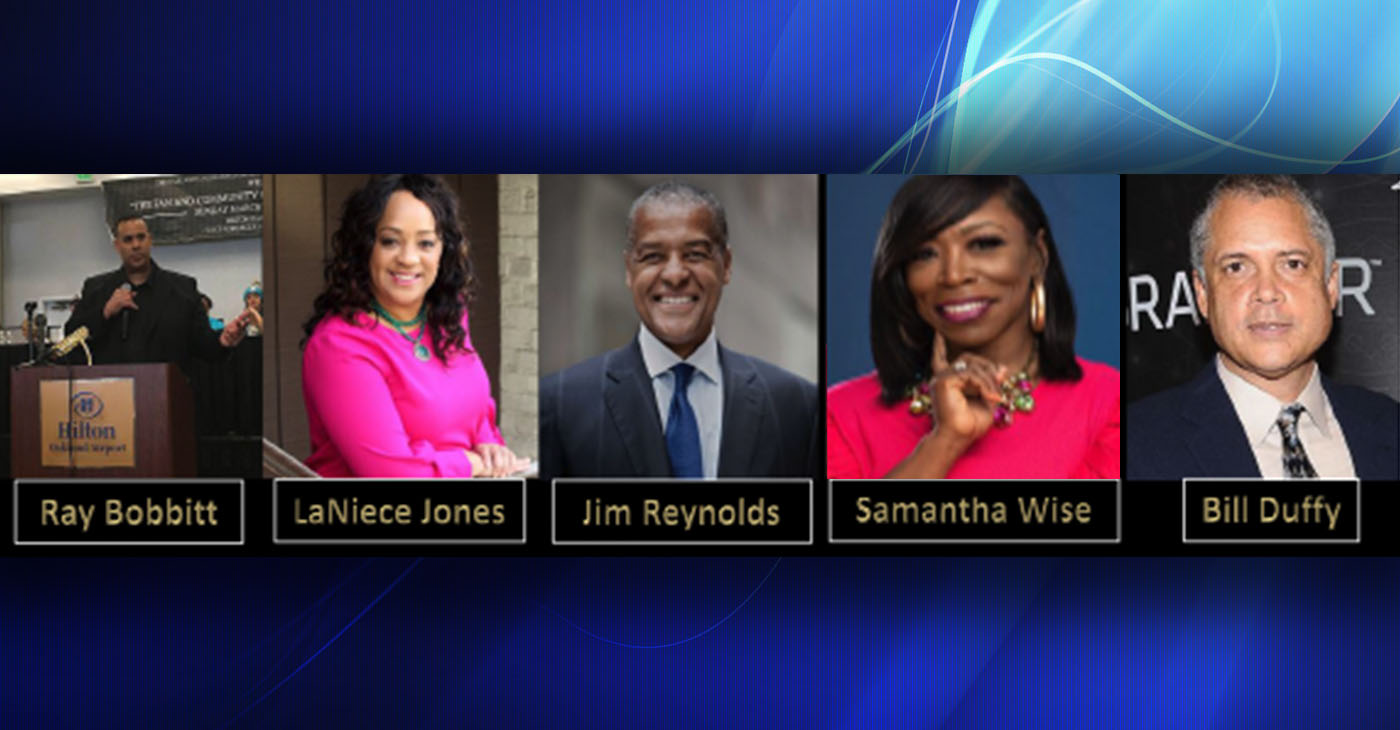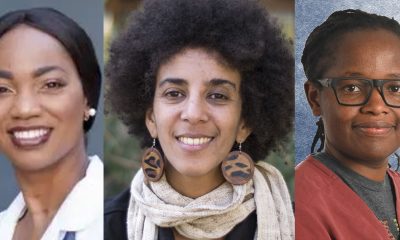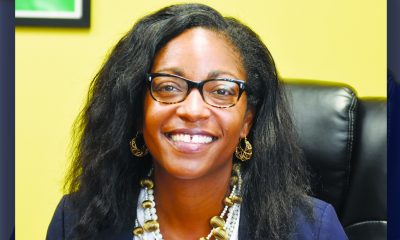Bay Area
OPINION: AASEG Will Bring African American Ownership and Self-Determination to Coliseum
“What is not up for debate is the experience, financial wherewithal, dedication, and temperament of the AASEG. Win, lose or draw, their model of 100% African American ownership, equity, and self-determination is worthy of imitation by the entire African American community.”

Publisher’s note: Below is the text of a media statement from the African American Sports and Entertainment Group (AASEG), which was edited by Post staff.
On Juneteenth last year, the African American Sports & Entertainment Group (AASEG) held a press conference to announce bold and historic endeavor.
With the nation still reeling from the videotaped murder of George Floyd, the AASEG declared that the time was long overdue for African Americans to have equity and ownership of land, housing, and real estate within their communities.
The group then announced that they intended to purchase and develop the Oakland Coliseum site, in the heart of Oakland’s African American community.
It is a common fact that whenever African Americans assemble to do something noteworthy, especially in the realms of business and finance, their capabilities and experience are often called into question.
The AASEG has not been immune to these kinds of baseless and frankly, racist attacks. However, the evidence shows that one would be hard pressed to find another group more qualified to accomplish this historic endeavor than the AASEG.
“What is not up for debate is the experience, financial wherewithal, dedication, and temperament of the AASEG. Win, lose or draw, their model of 100% African American ownership, equity, and self-determination is worthy of imitation by the entire African American community.”
Introducing AASEG’s members
Alan Dones is one of Oakland’s most successful African American developers. He is the CEO and co-founder of SUDA, LLC, specializing in large-scale, innovative, public agency projects and mixed-use developments.
Dones has led development projects both in the United States and overseas. In addition, his company is currently spearheading multiple development projects throughout the City of Oakland at this very moment.
Robert C. Bobb is well-versed in municipal consulting and partnerships. He is the owner, president and CEO of The Robert Bobb Group, LLC (RBG), a multi-faceted private/public sector consulting firm.
Bobb is the former city manager of Oakland, former city administrator and deputy mayor for Wash., D.C., and served as the District of Columbia’s Homeland Security advisor. Bobb is also the founding president of the Oakland African American Chamber of Commerce.
In 2005, while serving as city administrator and deputy mayor in Wash., D.C., Bobb was primarily responsible for that city acquiring the 2019 World Series Champions, the Washington Nationals, and developing a new $1 billion ballpark there. City revenues based on the development have more than doubled since 2006, and the bonds will be completely paid off 11 years earlier than expected.
Bill Duffy is one of the country’s most successful African American sports agents. Among his clients are current NBA superstar Luka Doncic and the 2020 WNBA No. 1 overall pick, Sabrina Ionescu.
He was named to the ‘World’s Most Powerful Sports Agents 2019’ list by Forbes Magazine. Duffy has agreed to apply his extensive network and decades of experience toward execution of the AASEG project.
Loop Capital, LLC – Loop Capital is the largest African American owned, full services, global investment firm in the United States.
Loop Capital’s CEO, Jim Reynolds, is a frequently featured contributor on CNBC and a partner in JLC Infrastructure, a private asset manager with over $800 billion under its management. In addition, Jim Reynolds holds the prestigious distinction of being chosen by former President Barack Obama to personally oversee his entire campaign finance strategy for both of his presidential campaigns.
Loop Capital is also an experienced advisor on Public-Private Partnership and infrastructure transactions. And, relevant to the AASEG effort, Loop Capital has underwritten offerings for the cities of Oakland and San Francisco as well as Alameda County.
The Unique Strength of AASEG
After AASEG made their announcement on Juneteenth of 2020, several other developers came forth expressing their desire to submit competing proposals to purchase the Coliseum site.
It should be noted that almost all development projects in the country — even those with prominent African Americans involved — rely on capital and financing by white or non-Black funding sources.
That is not so with AASEG.
The development model established by the AASEG utilizes Black investment dollars, and specifically, the largest African American investment bank in the country to fund their project. To call this unprecedented would be an understatement.
Whether or not the AASEG ultimately gets approved to enter into an exclusive negotiating agreement with the City of Oakland leading to the purchase and development of the Coliseum site is a decision that must be made by the Oakland City Council. History will be the ultimate judge of their decision.
However, what is not up for debate is the experience, financial wherewithal, dedication, and temperament of the AASEG. Win, lose or draw, their model of 100% African American ownership, equity, and self-determination is worthy of imitation by the entire African American community.
Activism
Asm. Corey Jackson Proposes Safe Parking for Homeless College Students Sleeping in Cars
Assemblymember Corey Jackson (D-Moreno Valley), a member of the California Legislative Black Caucus (CLBC), is the author of AB 90, which would require community colleges and California State University campuses to create overnight parking programs where students can sleep safely in their vehicles. With one in four community college students in California experiencing homelessness in the past year, Jackson says the state must act urgently.

By Bo Tefu
California Black Media
As California’s housing crisis continues to impact students, new legislation, Assembly Bill (AB) 90, promises to allow college students without stable housing to sleep in their cars on campus, offering a stark but practical solution aimed at immediate relief.
Assemblymember Corey Jackson (D-Moreno Valley), a member of the California Legislative Black Caucus (CLBC), is the author of AB 90, which would require community colleges and California State University campuses to create overnight parking programs where students can sleep safely in their vehicles. With one in four community college students in California experiencing homelessness in the past year, Jackson says the state must act urgently.
“This just deals with the harsh realities that we find ourselves in,” he said at a recent hearing.
The bill passed its first committee vote and is gaining attention as housing affordability remains a top concern across the state. California rents are more than 30% above the national average, and long waitlists for student housing have left thousands in limbo. CSU reported more than 4,000 students on its housing waitlist last year.
Supporters stress that the bill is not a long-term solution, but a humane step toward helping students who have no other place to go. A successful pilot program at Long Beach City College has already shown that safe, supervised overnight parking can work, giving students access to restrooms, Wi-Fi, and a secure environment.
However, the CSU and community college systems oppose the bill, citing funding concerns. Critics also worry about safety and oversight. But Jackson and student advocates argue the crisis demands bold action.
“If we know students are already sleeping in their cars, why not help them do it safely?” said Ivan Hernandez, president of the Student Senate for California Community Colleges.
Activism
Faces Around the Bay: Author Karen Lewis Took the ‘Detour to Straight Street’
“My life has been a roller-coaster with an unlimited ride wristband! I was raised in Berkeley during the time of Ron Dellums, the Black Panthers, and People’s Park. I was a Hippie kid, my Auntie cut off all our hair so we could wear the natural styles like her and Angela Davis.

By Barbara Fluhrer
I met Karen Lewis on a park bench in Berkeley. She wrote her story on the spot.
“My life has been a roller-coaster with an unlimited ride wristband! I was raised in Berkeley during the time of Ron Dellums, the Black Panthers, and People’s Park. I was a Hippie kid, my Auntie cut off all our hair so we could wear the natural styles like her and Angela Davis.
I got married young, then ended up getting divorced, raising two boys into men. After my divorce, I had a stroke that left me blind and paralyzed. I was homeless, lost in a fog with blurred vision.
Jesus healed me! I now have two beautiful grandkids. At 61, this age and this stage, I am finally free indeed. Our Lord Jesus Christ saved my soul. I now know how to be still. I lay at his feet. I surrender and just rest. My life and every step on my path have already been ordered. So, I have learned in this life…it’s nice to be nice. No stressing, just blessings. Pray for the best and deal with the rest.
Nobody is perfect, so forgive quickly and love easily!”
Lewis’ book “Detour to Straight Street” is available on Amazon.
Activism
Barbara Lee Accepts Victory With “Responsibility, Humility and Love”
“I accept your choice with a deep sense of responsibility, humility, and love. Oakland is a deeply divided City,” Lee said in an April 19 statement. “I answered the call to run to unite our community, so that I can represent every voter, and we can all work together as One Oakland to solve our most pressing problems.”

By Antonio Ray Harvey,
California Black Media
As a candidate for mayor, former U.S. Representative Barbara Lee released a “10-point plan” last week to reassure residents that she will tackle Oakland’s most pressing challenges.
Now that she has edged out her competitors in the ranked-choice special election with 50% or more of the vote, the former Congresswoman, who represented parts of the Bay Area in the U.S. House of Representatives, can put her vision in motion as the city’s first Black woman mayor.
“I accept your choice with a deep sense of responsibility, humility, and love. Oakland is a deeply divided City,” Lee said in an April 19 statement. “I answered the call to run to unite our community, so that I can represent every voter, and we can all work together as One Oakland to solve our most pressing problems.”
On Saturday evening, Taylor conceded to Lee. There are still about 300 Vote-by-Mail ballots left to be verified, according to county election officials. The ballots will be processed on April 21 and April 22.
“This morning, I called Congresswoman Barbara Lee to congratulate her on becoming the next Mayor of Oakland,” Taylor said in a statement.
“I pray that Mayor-Elect Lee fulfills her commitment to unify Oakland by authentically engaging the 47% of Oaklanders who voted for me and who want pragmatic, results-driven leadership.”
The influential Oakland Post endorsed Lee’s campaign, commending her leadership on the local, state, and federal levels.
Paul Cobb, The Post’s publisher, told California Black Media that Lee will bring back “respect and accountability” to the mayor’s office.
“She is going to be a collegial leader drawing on the advice of community nonprofit organizations and those who have experience in dealing with various issues,” Cobb said. “She’s going to try to do a consensus-building thing among those who know the present problems that face the city.”
Born in El Paso, Texas, Lee’s family moved to California while she was in high school. At 20 years old, Lee divorced her husband after the birth of her first child. After the split, Lee went through a tough period, becoming homeless and having to apply for public assistance to make ends meet.
But destitution did not deter the young woman.
Lee groomed herself to become an activist and advocate in Oakland and committed to standing up for the most vulnerable citizens in her community.
Lee traveled to Washington, D.C. to work for then U.S. Congressman Ron Dellums after receiving a Bachelor of Arts degree from Mills College in Oakland in 1973. Lee later won a U.S. Department of Housing and Urban Development (HUD) fellowship to attend the School of Social Welfare, and she earned a Master of Social Work from the University of California-Berkeley in 1975.
Lee later served in the California State Assembly and State Senate before she was elected to Congress in 1998.
After serving in the U.S. Congress for more than 25 years, Lee ran unsuccessfully for California’s U.S. Senate in the 2024 primary election.
Lee joins current Los Angeles mayor Karen Bass and former San Francisco Mayor London Breed as Black women serving as chief executives of major cities in California over the last few years.
-

 Activism4 weeks ago
Activism4 weeks agoOakland Post Endorses Barbara Lee
-

 Activism3 weeks ago
Activism3 weeks agoOakland Post: Week of April 2 – 8, 2025
-

 #NNPA BlackPress3 weeks ago
#NNPA BlackPress3 weeks agoTrump Profits, Black America Pays the Price
-

 Activism2 weeks ago
Activism2 weeks agoOakland Post: Week of April 9 – 15, 2025
-

 #NNPA BlackPress3 weeks ago
#NNPA BlackPress3 weeks agoHarriet Tubman Scrubbed; DEI Dismantled
-

 #NNPA BlackPress3 weeks ago
#NNPA BlackPress3 weeks agoTrump Targets a Slavery Removal from the National Museum of African-American History and Culture
-

 #NNPA BlackPress3 weeks ago
#NNPA BlackPress3 weeks agoLawmakers Greenlight Reparations Study for Descendants of Enslaved Marylanders
-

 #NNPA BlackPress3 weeks ago
#NNPA BlackPress3 weeks agoNew York Stands Firm Against Trump Administration’s Order to Abandon Diversity in Schools




















































